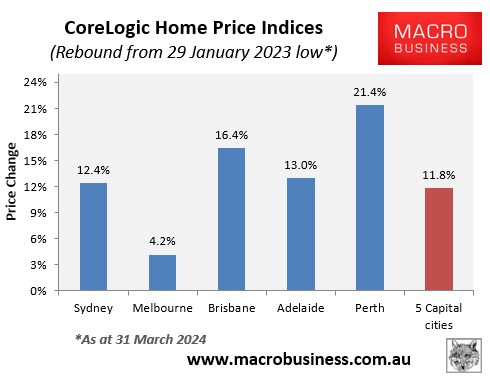CoreLogic’s daily dwelling values index showed that home prices across the five major capital city markets have risen by 11.8% since bottoming on 29 January 2023, despite significant additional monetary tightening from the Reserve Bank of Australia (RBA):

On Monday, PropTrack released its own dwelling values index, which showed that values across the combined capital cities rose another 0.40% in March to be 9.2% higher than its trough in December 2022:

The next table shows the breakdown by market, with Perth leading the nation’s growth in both monthly (0.99%) and annual (18.62%) terms:

Commenting on the results, PropTrack senior economist Eleanor Creagh noted that the rebound in values despite the RBA’s monetary tightening has been driven by an “imbalance between supply and demand”, which is likely to continue for the foreseeable future:
“Housing demand is being buoyed by population growth, tight rental markets, resilient labour market conditions and home equity gains”.
“Meanwhile, the sharp rise in construction costs and labour and materials shortages have slowed the delivery of new builds, hampering the supply of new housing”.
“The imbalance between supply and demand is likely to futher offset the impact of affordability constraints and a slowing economy. As a result, prices are expected to remain on the rise in the months ahead”.
Creagh also noted that “the expectation that interest rates may begin to move lower in late 2024 will sustain buyer and seller confidence”.
The “imbalance between supply and demand” is illustrated by the below charts.
First, Australia’s population swelled by a record 660,000 in the year to September 2023, driven by record net overseas migration of 549,000:

Second, at the same time as Australia’s population has boomed, actual dwelling construction rates have collapsed to decade lows:

The upshot is that Australia’s housing market is suffering from an acute housing shortage, which has driven extreme FOMO (‘Fear of Missing Out’) from buyers while also driving rents through the roof:

Home prices will likely get another kick-along later this year when the RBA commences its interest rate easing cycle, while rents will continue to inflate as population demand continues to dwarf housing supply.
It is a nightmare scenario for renters seeking to become homeowners.
The goal of home ownership will continue to drift further out of reach.

